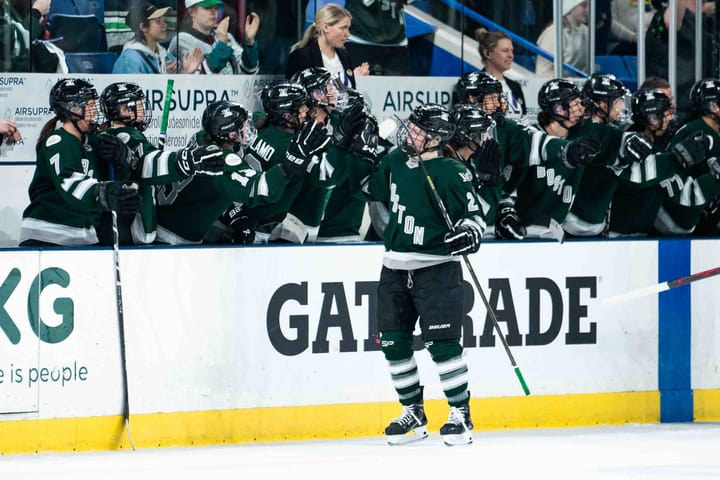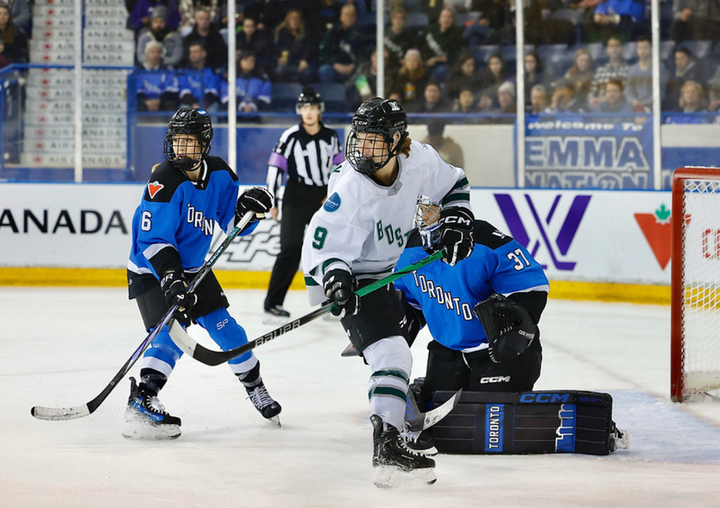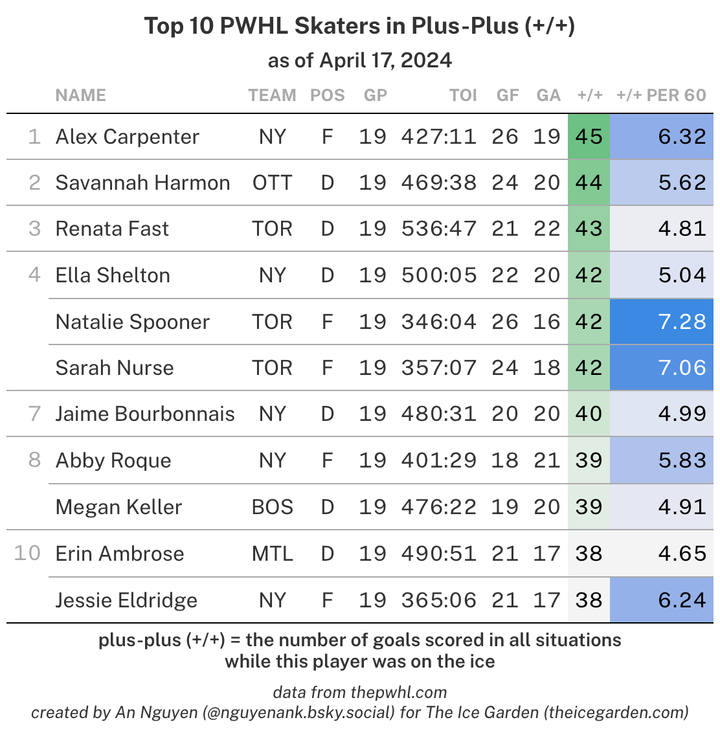Origins: How Hayley Wickenheiser changed the game
Hockey Canada’s greatest icon set a new standard for greatness
On Nov. 18, Hayley Wickenheiser will become the seventh female player to enter the Hockey Hall of Fame. The fact that Wickenheiser’s place in the HHOF was never in question speaks volumes about her achievements and reputation. Her level of excellence demanded the attention of the hockey world, even when the talents of so many of her peers went unrecognized because of their gender.
For many, Wickenheiser has become an avatar of competitive spirit. Although she is just 40, she’s already achieved hockey immortality for the role that she has played in the greatest rivalry in team sports. The image of a stony-faced Wickenheiser lining up for a faceoff against a player in a Team USA sweater is the sort of stuff that should be painting on ceilings.
We have no way to measure the direct impact that Wickenheiser had on the growth of the game, but we all know that it has been massive. Legions of fans first started paying attention to the women’s game because of her and legions more were inspired to step into skates after watching her play. It’s safe to say that women’s hockey wouldn’t be where it is today without Wick.
Related
Hayley Wickenheiser named to Hockey Hall of Fame
An undeniable Talent
At 5-foot-10, Wickenheiser was a force to be reckoned with on the ice. Her stick strength and balance made it nearly impossible for opposing players to knock her off the puck. As a natural center, she was nearly impossible to defeat on the faceoff dot throughout her career. It may be hard to believe because of her fame, but her two-way game was often overlooked because when her line was on the ice it almost always had the puck.
Wickenheiser was ahead of her time in more ways than one. Many of the top forwards in women’s hockey at the end of the millennium were small, quick skaters with quicker hands; Jayna Hefford, Riikka Sallinen, and Jenny Potter are all listed at 5-foot-4. Wickenheiser, Caroline Ouellette, and Maria Rooth were bigger, stronger models with explosive strides and punishing shots.
Wickenheiser is the archetypal power forward that has become so prevalent in today’s game. Her blend of size, skill, and powerful skating is echoed in the games of players like Hilary Knight, Natalie Spooner, and Jennifer Wakefield. To be clear, Wick wasn’t the first big forward to make a significant impact in the women’s game, but she definitely broke the mold.
When Wick made her national team debut at 1994 Women’s World Championships at the age of 15, she was the second biggest player on Team Canada. She turned absorbing contact while making plays into an art form, as evidenced by the high volume of assists she put up throughout her career.
The multi-sport athlete was never the fastest player on the ice, but Wickenheiser had a powerful stride that allowed her to slip and burst past defenders when she wasn’t powering her way through them. Her versatile skill set made her effective both on the perimeter and in the slot, where she had a gift for tipping pucks, finding rebounds, and banging home cross-crease passes. In the later stages of her career, she transitioned into a pass-first playmaker who undressed defenses with her vision and crisp passing.
There is perhaps no greater testament to Wickenheiser’s skill than the fact that she made Canada’s national team at age 15. She was 20 years younger than team captain France St. Louis when she picked up her first point — an assist — in that tournament. Remember, there was no Olympic tournament for women in 1994, so a gold medal at the Worlds was the top of the mountain at that time and Wick reached it at the age of 15. To this day, she remains the youngest player to ever represent her country at the Worlds.
Stepping into the Spotlight
Wickenheiser and the rest of the world had to wait until 1997 until the next IIHF World Championship. In the three years that had passed since her national team debut, the pride of Saskatchewan had brought her game to another level.
She was no longer the nervous 15-year-old prodigy who followed Angela James’ suggestion to feed her the puck; she was a fierce competitor who was ready to make an impact. The 1997 Worlds in Kitchener served as the qualifier for the first Olympic women’s hockey tournament. Needless to say, there was a lot on the line for the host nation and for the teenager.
With the world watching, Wickenheiser scored four goals and picked up five assists in five games, including the primary assist on Nancy Drolet’s overtime goal in the gold medal game against Team USA. The 18-year-old led Team Canada — which featured four other eventual Hockey Hall of Famers — in scoring. Riikka Sallinen, Finland’s ageless icon, was the only player to score more points at the 1997 Worlds than Wick.
Defining Greatness
Although she and Canada came home with silver in Nagano, Wickenheiser put the hockey world on notice by scoring two goals and notching six assists at the 1998 Olympics. She was the highest-scoring teenager in the tournament and finished second in scoring on Team Canada behind fellow Hockey Hall of Famer Danielle Goyette.
Four years later, Wickenheiser had nothing but Olympic gold on her mind after winning gold with Canada at the 1999 and 2000 Worlds. A knee injury that kept her off of the ice for the 2001 Worlds only added fuel to that fire.
Wickenheiser was, in a word, unstoppable at the Salt Lake City Games. She scored a career-best seven goals in the tournament to help pave the way to Canada’s much-awaited first Olympic gold. She was also named the tournament’s MVP and Best Forward for the 10 points she notched in five games, which was matched only by Goyette and Cammi Granato.
One of the worst officiated games in hockey history wasn’t enough to keep Wickenheiser and Canada from taking gold from Team USA on Feb. 21, 2002. In the gold medal game, she scored a goal, put four shots on net, and helped Canada kill an avalanche of American power plays. Despite being charged with 13 minor penalties to Team USA’s six, Canada edged out an improbable 3-2 win.
After the game, with her teammates still celebrating on the ice, a fiery Wickenheiser was asked a question by Don Cherry that prompted one of the most unforgettable quotes in hockey history. To this day, Wickenheiser’s jab at a freshly defeated Team USA remains a crown jewel in the rivalry between the two superpowers.
The Trailblazer
After winning her first Olympic gold, Wickenheiser was hungry for a new challenge and a way to continue developing her game. She turned down an offer to play in the ECHL and set her sights on playing pro men’s hockey in Italy with the Merano Eagles, but the Italian Ice Hockey Federation ruled that she was ineligible to play because of her gender.
Instead of accepting defeat, Wickenheiser made history by going pro with Kirkkonummi Salamat in Suomi-sarja, Finland’s third division.
Although her teammates accepted her on the ice, Wickenheiser played with a target on her back in Finland; she came away from her first game with a broken nose. But the physicality of the men’s game didn’t stop her from making an impact. Wickenheiser finished the season with the best faceoff numbers on Salamat and made history when she became the first woman to score a point in a professional men’s hockey game; she would add another 10 before her season was over.
Salamat won the third division with Wickenheiser in the lineup and was promoted to Mestis, Finland’s second-tier league, the following season. After ten games of averaging “about 10 minutes” a game in her second season with Salamat, Wickenheiser decided to return home to Canada.
In her return to North America, she won her second Olympic gold, four more golds at the Worlds, had three dominant seasons in the WWHL with the Calgary Oval X-Treme, and received two invitations to Philadelphia Flyers rookie camps. In the 2008-09 season Wickenheiser played Division 1 pro men’s hockey in Sweden with Eskilstuna Linden. She picked up three points in 21 games with Linden, which proved to be her last season of pro men’s hockey.
Wickenheiser became an Olympic champion in 2010 and 2014, which made her one of a select few athletes to win four consecutive gold medals at the Winter Games. During that same time she pursued a degree in kinesiology and played college hockey at the University of Calgary. In 2011, at the age of 32, Wickenheiser was named the MVP of the CIS (now known as USports). She averaged an impressive 1.97 points per-game (Pts/GP) during her collegiate career with the Dinos.
Following the conclusion of her collegiate career, Wickenheiser played her first and only season of CWHL hockey with the Calgary Inferno. At the age of 37, Wickenheiser picked up 10 primary assists at even strength in 23 games in the 2015-16 CWHL regular season. She followed that performance by picking up three points in three playoff games, including two assists in the final, to help the Inferno lift the 2016 Clarkson Cup.
On Jan. 24, 2017, she announced her retirement from the game of hockey. One year later, Wick made history again when she joined the front office of the Toronto Maple Leafs as the assistant director of player development.
Measuring Greatness
When we measure greatness in women’s hockey, it’s only natural to turn to Olympic performance. After all, the Olympic tournament is the pinnacle of competition in the sport. It is where the spotlight is at its brightest and the pressure is at its greatest. For the modern game, the Olympics are where hockey legends are made. And there is no Olympic legend as great as Wickenheiser.
Wickenheiser is the all-time leading scorer in both Olympic and World Championship hockey. She scored 51 points in 26 games of Olympic hockey and 86 points in 61 games at the Worlds. It’s important to note again that she missed the 2001 Worlds due to an injury and that the 2003 Worlds in Beijing was canceled because of the SARS outbreak. So, Wickenheiser averaged 1.41 Pts/GP in Worlds competition despite missing two tournaments during the prime of her career.
As one might suspect, the length of Wickenheiser’s playing career — 23 years as a member of the Canadian national team — played a significant role in her ownership of those records. But her longevity is only half of the story.
The other half of the story? Wickenheiser’s rate of offensive production in major international tournaments is unparalleled. She is the only player in the history of the women’s game to average more than 1.6 Pts/GP who played in at least 16 games. Her ability to create offense stands head and shoulders above some of the most revered and respected names in women’s hockey.
One could argue that the only thing more remarkable than the length of Wickenheiser’s career is how long she held the crown as the best player in the world. Wickenheiser finished in the top-10 in scoring in all five of her Olympic appearances; she finished in the top-3 in scoring four times. At the height of her powers — which spanned from the 2002 to the 2006 Olympics — she was twice named the MVP of the Olympics and averaged 2.0 Pts/GP in Olympic and Women’s Worlds competition.
To state the obvious: she was incredible.
Wickenheiser was 35 when she participated in her fifth and final Olympics in Sochi. In addition to sharing the lead in scoring on Team Canada with Marie-Philip Poulin and Rebecca Johnston, Wickenheiser’s 21:30 TOI/GP led all Canadian forwards. She also won more faceoffs than any other player in the tournament.
In the gold medal game against USA, Wickenheiser drew a penalty that gave Canada the power play opportunity they needed to end the game in overtime. Fittingly enough, she also provided the screen on Poulin’s gold medal-winning goal. She didn’t get credited with a point on the play, but her fingerprints were all over it.
What Wickenheiser achieved on the ice during her 23-year career will be remembered for generations. She is, and will long remain, the gold standard against which all other great players will be measured.
She changed the game.
All data courtesy of IIHF.com, eliteprospects.com, theCWHL.com, and the author’s own research and tracking.





Comments ()